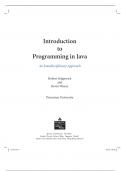Class notes
class notes computer
- Course
- Institution
Introdection of java language Elements of Programming . . . . . . . . . . . . . 3 1.1 Your First Program 4 1.2 Built-in Types of Data 14 1.3 Conditionals and Loops 46 1.4 Arrays 86 1.5 Input and Output 120 1.6 Case Study: Random Web Surfer 162 Functions and Modules . . . . . . . . . . . . ...
[Show more]



